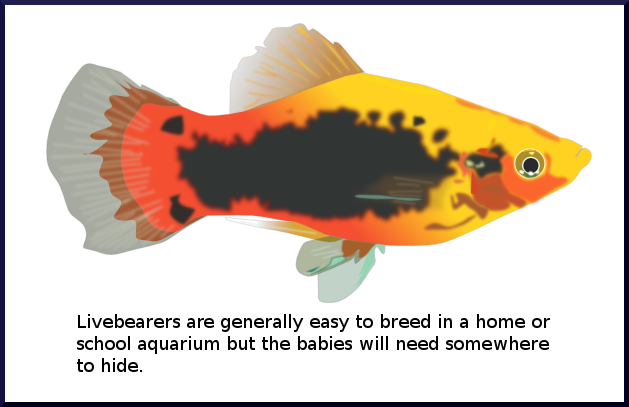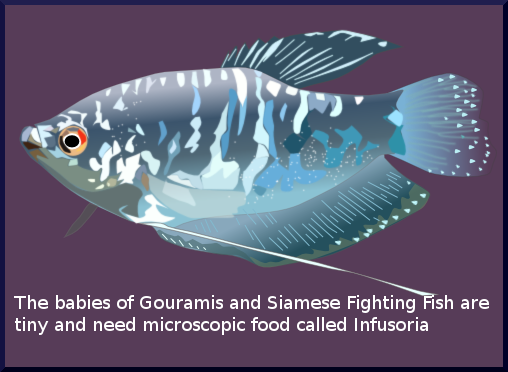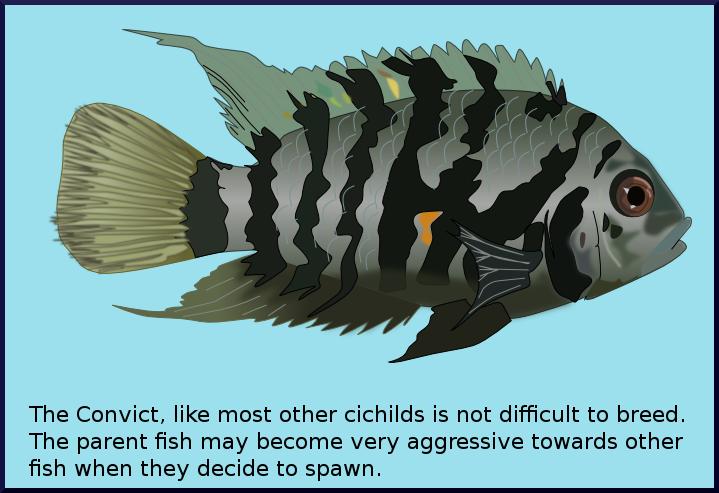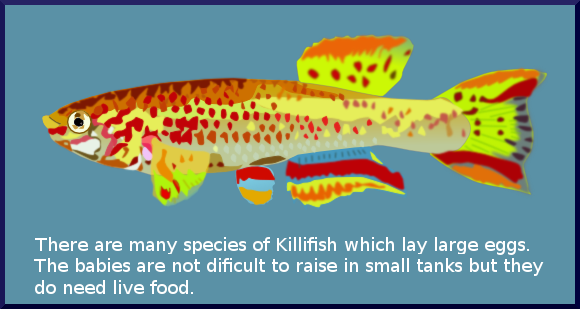Breeding and raising tropical fish
 Guppies, swordtails, mollies and platies are called “livebearers” because their babies come out of the mother fish already swimming around. These are the easiest fish to breed in a home or school aquarium. The babies are quite big (for fish babies) and they will eat normal fish food if you crush it up for them. The biggest problem you might have is other fish, including their parents, eating the babies. This happens because, in nature, babies usually go somewhere and hide until they are big enough not to be eaten. In a fishtank, it can be hard for them to find somewhere to hide. Some people will have another aquarium set up just for babies but sometimes you can also help them survive by putting some floating plants in the tank for them to hide in or getting a “breeding net” or breeding box that hangs inside the main aquarium. You can catch the babies and put them in the net or box until they are big enough to go back with their parents.
Guppies, swordtails, mollies and platies are called “livebearers” because their babies come out of the mother fish already swimming around. These are the easiest fish to breed in a home or school aquarium. The babies are quite big (for fish babies) and they will eat normal fish food if you crush it up for them. The biggest problem you might have is other fish, including their parents, eating the babies. This happens because, in nature, babies usually go somewhere and hide until they are big enough not to be eaten. In a fishtank, it can be hard for them to find somewhere to hide. Some people will have another aquarium set up just for babies but sometimes you can also help them survive by putting some floating plants in the tank for them to hide in or getting a “breeding net” or breeding box that hangs inside the main aquarium. You can catch the babies and put them in the net or box until they are big enough to go back with their parents.Fish that lay eggs are harder to breed in a home or school aquarium because their babies are usually much smaller than livebearer babies and will need some special food when they hatch and start to swim around. Lots of fish will eat the eggs too, so you will usually need a separate aquarium for egg-layers to breed and then you take the parents out when they have laid eggs. There are some fish, like Convict and Jewel cichlids and Angelfish, that look after their babies very well but most egg-layers don't do that.
The best food for egg-layer babies will depend on the type of fish and how big the babies are.
 Very, very small babies like those of Siamese Fighting fish and Gouramis and many tetras, need the tiniest foods when they first hatch. The best tiny foods are microscopic animals called “infusoria” that eat bacteria. Infusoria are all around us and will be any water left outside for even just a few days. To feed tiny baby fish, you need to get lots of it and the best way to do that is to make an “Infusoria Culture”. It is pretty easy – there is a recipe here: http://www.wikihow.com/Make-Infusoria.
Very, very small babies like those of Siamese Fighting fish and Gouramis and many tetras, need the tiniest foods when they first hatch. The best tiny foods are microscopic animals called “infusoria” that eat bacteria. Infusoria are all around us and will be any water left outside for even just a few days. To feed tiny baby fish, you need to get lots of it and the best way to do that is to make an “Infusoria Culture”. It is pretty easy – there is a recipe here: http://www.wikihow.com/Make-Infusoria.As the babies grow, they will need different foods. You can buy powdered food for them from an aquarium shop or make your own by crushing normal dry fishfood very finely. You can also grow special “live” foods for them – like Brine Shrimp, microworms or vinegar eels. All fish LOVE live food and grow faster and are healthier if that have some live food in their diet instead of just dry food like flakes or pellets.
 The babies of some egg-layers, like all the cichlids and killifish and many catfish, can eat these bigger foods straight away – they don't need infusoria.
The babies of some egg-layers, like all the cichlids and killifish and many catfish, can eat these bigger foods straight away – they don't need infusoria.Here are some links to websites with information on the different types of live foods you can grow for baby fish. You won't need every type, even if you start breeding lots of different fish. Just a couple will be enough to give your fish the diet they need.
Microworms
Vinegar “Eels” (actually, they are really worms)
Brine Shrimp
Here is a list of some common fish and some information on how they breed and how to look after their babies. There is lots more information available in books and on the web so do some more research if you are interested in breeding fish.
|
Type of Fish |
Breeding Set-up |
Care of Babies |
Other information |
|
Livebearers (guppies, platies, mollies etc.) |
Breeding net or box or a tank with lots of hiding places for babies |
Easy – crushed dry food is OK |
Babies will grow faster if they have lots of room and get some live food like brine shrimp or micro-worms. A fun group to breed, especially for younger fish-keepers. |
|
Cichlids (eg. convict, jewel, kribensis, firemouth, angel fish, rams) |
A tank with just a pair (male and female) is best. Feed them well and provide rocks, caves and large-leaved plants (research what your species prefers to lay its eggs on). |
The parents will look after the eggs and babies (but will sometimes eat them!). Wait until the babies are actually swimming off the botton – 3 or 4 days after hatching and start feeding them brineshrimp or micro-worms |
If there are other fish in the tank, they might get bashed-up. You can take one or both parents out of the breeding tank when the babies are swimming freely. You need to watch carefully and work out if one parent is doing the all childcare and remove the other one. A very rewarding group of fish to breed as they display complex behaviours and have a lot of "personality". |
|
Killifish (“egg-hanger” types) |
A small tank (20 litres) with one male and one or two females. Feed them well and provide a “spawning mop” or lots of fine leaved plants. |
Eggs take at around two weeks to hatch (and can be watched if you take them off the mop!). Most killifish babies are quite large and will take brineshrimp or microworms when they hatch. |
You can use small containers to collect and hatch the eggs and raise the babies for a few weeks - but you need to keep the water clean and warm and remove uneaten food. Killis grow quickly and must have live food. Killis don't lay a lot of eggs in one spawning, so you may need several small tanks to keep a few batches of babies. Killis can be hard to find in shops, but there will probably be breeders in your area. They are a great project fish for anyone interested in observing egg development. Killis also very interesting ecologically - providing lots of opportunities for discussion and further research. |
|
Siamese Fighters and Gouramis |
A tank with just one pair or one male and two females. Water must be fairly still and you need floating plants or a floating cup for them to build their bubble nest. |
The babies are almost microscopic and need infusoria when they are swimming freely – about 5 days after spawning. |
Males do all the childcare so remove female parents after spawning. Once babies are swimming and eating, the male can also be removed. Probably not a good "first" fish to breed because the babies are so small. |
|
Zebra Danios and other “egg scatterers” |
A group of 3 to 8 adults is best – more females than males if possible. Have fine leaved plants or moss in the tank and cover the bottom with marbles or netting to protect the eggs from the parents. |
The babies are quite small and need a week or two feeding on infusoria. |
Take out the parents after spawning – they will eat any eggs or babies they can find. They can lay hundreds of eggs, so a 60 litre tank is probably the smallest you should use for each batch of babies. These fish can be challenging to breed successfully. |
|
Bristlenose Catfish |
A male (the one with whiskers!) and a female in a tank of at least 60 litres with caves. Feed them algae pellets and have a piece of aquarium-safe driftwood in the tank. |
No care required! Bristlenose babies will eat algae pellets and driftwood just like their parents. |
Bristlenose will often breed in a community tank but other fish might eat the babies. If you have a male and female of breeding age, success is (almost) guaranteed. |
There are, of course, thousands of other types of fish you could breed. Don't be disappointed if it doesn't work first time. Try again and do a bit more reading about your particular fish. Sometimes you will need to go to bit of extra trouble making sure that their water is “just right”. Some other “professional tricks” you could try to get difficult fish to breed include:
- Separating the males and females for a week or so and feeding them with live foods before putting them together in the breeding tank; and
- Doing a large (say, 50%) water change – or raising the temperature by a couple of degrees - after they settle into the breeding tank.
 This article only tries to cover the basics of breeding and raising fish. Success rates will vary. The best help you can give is ensuring that an enthusiastic child or class has:
This article only tries to cover the basics of breeding and raising fish. Success rates will vary. The best help you can give is ensuring that an enthusiastic child or class has:1) a dedicated “breeding tank” (in addition to their “main aquarium”) set up appropriately for the species they are trying to breed and raise; and
2) help obtaining and managing one or more suitable live food cultures.
The other thing you can do is make sure the kids have fish that will breed. They certainly need a male and at least one female (which can sometimes be hard to determine) and success is more likely if the fish have bred before. You could contact a local Aquarium Society or serious fish keeper and ask if they can help get hold of breeders for you. Many serious hobbyists would be happy to help and often have excess breeding pairs that would be suitable for a school project. Getting your stock from a pet shop, even a specialist Aquarium shop, could be a bit hit and miss as the staff are not always knowledgeable about breeding fish and many fish sold in shops are immature.
Aquariums for breeding and raising babies don't generally require substrate (ie gravel) or elaborate set ups – an air driven sponge filter will usually be adequate, along with a heater and some form of lighting. Do make sure it is set-up and “cycled” well before fish are introduced. Doing this before school holidays – and leaving the tank unstocked but operating for a few weeks – will help ensure success. Basic water testing and management and tank cleaning should be done after the tank has “cycled” and throughout the breeding/raising process.
Choosing which type of fish to breed should involve a little more research by both you and the child/class. Selecting something “easy” is a good first strategy. Discussing the fish's breeding biology, what you already know and expect, how you will manage each stage of spawning and raising the young is a great starting point and will help identify any problem areas before you get too committed.
If appropriate, you could encourage the keeping of a “fish breeding diary” to record the process and any problems (and solutions) that arise.
Encouraging a child or class to breed no more than one species per school term would help keep the workload manageable – and make “re-homing” the extra fish at the end of term a bit easier.
If you have any suggestions on improving this article, please let CDAS know via our contact form.
